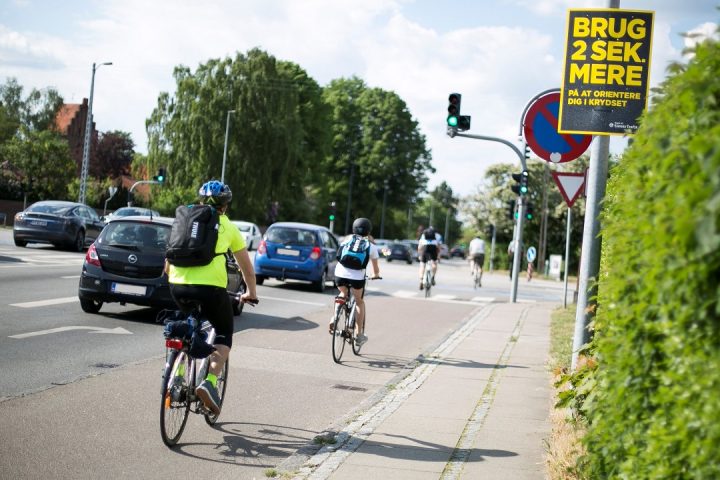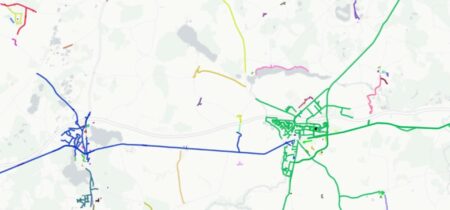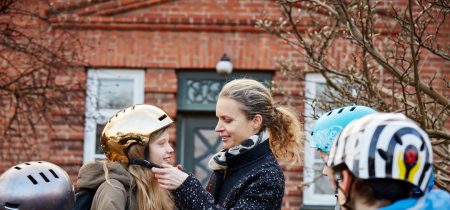Traffic safety and cyclist sense of security
Traffic safety and cyclist security are key concepts when working with bicycle traffic. With the right solution the two objectives can be combined.
By Troels Andersen
“Safety” and “security” should be the starting point for all bicycle traffic planning. They are two different things.
Security is the cyclist’s subjective perception of the danger of cycling in traffic whereas safety is an objective registration of accidents. Security or insecurity may be registered in various types of interviews: focus groups, telephone surveys, person-on-the-street interviews. Safety, or rather accidents, are registered by the police or the hospital accident and emergency department, and are divided into accidents with or without personal injury. Accidents may be calculated on the basis of number, density, frequency, risk, etc.

- Shortened cycle track. When cars and cyclists weave, weaker cyclists feel insecure. Photo: City of Copenhagen
The shortened cycle track is the classical example to illustrate the difference between safety and security. Shortened cycle tracks were originally introduced to expedite right turning cars at traffic light intersections. As it turned out, the solution where cyclists and cars weave is perfectly safe. Cyclists, however, often feel insecure and prefer to have their own area continue all the way up to the stop line. It’s usually possible to design a solution that’s both safe and secure, but unfortunately in some cases the cycle track up to the stop line is not as safe as the shortened cycle track.
If the aim is to get more people to cycle, cyclists need to perceive the situation as secure. It is crucial that men, women, children, and the elderly all feel secure if more people are to cycle.
Fortunately cycling is relatively safe in Denmark. There are more Danes that die of inactivity than in traffic accidents.
Children cycle if they’ve learned how and if they’re allowed to. Making it safe for them is largely the local authority’s responsibility. Set-back stop lines for cars, cycle crossings, and a narrow cycle lane up to the intersection instead of a shortened cycle track are possible solutions. Another solution is to continue the cycle track in full width all the way up to the intersection and protect cyclists in the intersection with blue cycle crossings and set- back stop lines for cars.
It is sometimes claimed that it’s good for traffic safety when cyclists feel somewhat insecure. It’s possible that this type of planning might work, but it would also mean that many people would refrain from cycling. If planners adopt the opposite standpoint instead, and plan for the weakest cyclist groups, all types of cyclist will be able to use the infrastructure.

- Narrow cycle lane up to the intersection. Cyclists are visible and have their own area. Photo: City of Copenhagen
Safety design
The safe-explaining road is the be – all and end- all of modern traffic planning, i.e. a system where the road design is clearly consistent with function and the road user’s attention and vigilance is naturally sharpened. Road users should not be made to feel insecure in order to motivate them to be attentive; this should occur naturally as a consequence of speed, rules, social responsibility, etc.
The forgiving road is another principle based upon a systematic implementation of road safety measures in order to minimize the consequences of traffic mistakes. A road user may be forgiven even if the accident is his fault.
There are other means of drawing cyclists’ attention to a potentially dangerous situation than by making them feel insecure, for example, narrowing the road, which brings cyclists and cars closer together, or a speed bump that reduces speed and concentrates attention.
It’s easy to choose the correct solution on road stretches since traditional cycle tracks offer cyclists both safety and security. This is also true of cycle lanes, although less noticeably. All in all cycling lanes are better for cyclists than cycling in mixed traffic.
If planners wish to encourage more bicycle traffic in an area with few cyclists it might be worth considering whether it would be better to install many kilometers of cycle lane rather than a few kilometers of cycle track. If cycle lanes are established as an initial phase they should have full cycle track width so they easily can be upgraded to a cycle track. Cycle lanes and parking bays should not be too narrow for them to function properly together.

- Capacity issues on cycle tracks can be resolved by wider cycle tracks on stretches where there isn’t enough space. The blue cycle crossing shows the original cycle track width. Photo: City of Copenhagen
When cyclists need to share the area with many cars going at high speeds it’s important that the cyclists have enough space. For example, the inner traffic lane on a heavily trafficked city street without a cycle track should be wider than normal to prevent cyclists from being squeezed.

- Narrow cycle track. The art of the possible in Vesterbro, Aalborg where space was also needed for a bus stop and waiting facilities
In Denmark 30 km/h mopeds must use the cycle track. Although the share of mopeds has significantly dropped in cities, it might be advisable to keep mopeds in the traffic lane from the point of view of cyclist security. This would improve cyclist safety, but it is unclear what it would mean for moped safety.
Another category of traffic on the cycle tracks is the e-bike, which according to Danish law are bicycles which may go up to 25 km/h with electrical assistance.
Sources








